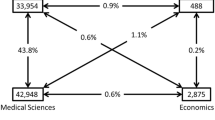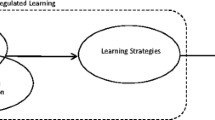Abstract
This commentary reviews the distinctions researchers make in defining metacognition, self-regulation, and self-regulated learning along with the methods used to explore these constructs. Bandura’s notion of reciprocal determinism (1977) is revisited in the context of situated learning, whereby interactions between the person, behavior, and environment take on new meaning when examining learning and affect in specific contexts where knowledge is constructed through interacting with all that the environment affords, be that material or human. The interaction between the mind and environment continues to be an interesting question with regard to these three constructs, and this interaction can be explored by using computers as cognitive tools. Technology-rich environments are described that provide opportunities for assessing and validating metacognition, self-regulation, and self-regulated learning with future directions for assessing co-regulation of teams of learners.
Similar content being viewed by others
References
Azevedo, R. (2005). Computer environments as metacognitive tools for enhancing learning. Educational Psychologist, 40, 193–197. doi:10.1207/s15326985ep4004_1.
Baker, L., & Brown, A. L. (1984). Metacognitive skills and reading. In P. D. Pearson (Ed.), Handbook of reading research (pp. 353–394). New York: Longman.
Bandura, A. (1977). Social learning theory. Oxford, England: Prentice-Hall.
Bandura, A. (1982). Self-efficacy mechanism in human agency. The American Psychologist, 37, 122–147. doi:10.1037/0003-066X.37.2.122.
Bandura, A. (1986). Social foundations of thought and action: A social cognitive theory. Englewood Cliffs, NJ: Prentice-Hall.
Boekaerts, M., & Cascallar, E. (2006). How far have we moved toward the integration of theory and practice in self-regulation? Educational Psychology Review, 18, 199–210. doi:10.1007/s10648-006-9013-4.
Brown, J. S., Collins, A., & Duguid, P. (1989). Situated cognition and the culture of learning. Educational Researcher, 18, 32–42.
Chi, M. T. H., Glaser, R., & Farr, M. J. (1988). The nature of expertise pp. ix–xvii. Hillsdale, NJ: Erlbaum.
Collins, A., Brown, J. S., & Newman, S. E. (1989). Cognitive apprenticeship: Teaching the craft of reading, writing, and mathematics. In L. B. Resnick (Ed.), Knowing, learning, and instruction: Essays in honor of Robert Glaser (pp. 453–494). Hillsdale, NJ: Erlbaum.
Corno, L., & Mandinach, E. B. (1983). The role of cognitive engagement in classroom learning and motivation. Educational Psychologist, 18(2), 88–108.
Dinsmore, D. L., Alexander, P. A., & Loughlin, S. M. (2008). Focusing the conceptual lens on metacognition, self-regulation, and self-regulated learning. Educational Psychology Review (this issue).
Ericsson, K. A. (2002). Attaining excellence through deliberate practice: Insights from the study of expert performance. In M. Ferrari (Ed.), The pursuit of excellence in education (pp. 21–55). Hillsdale, NJ: Erlbaum.
Flavell, J. H. (1971). First discussant’s comments: what is memory development the development of? Human Development, 14, 272–278.
Greeno, J. (1989). A perspective on thinking. The American Psychologist, 44, 134–141. doi:10.1037/0003-066X.44.2.134.
Hmelo-Silver, C. E., & Barrows, H. S. (2006). Goals and strategies of a problem-based learning facilitator. Interdisciplinary Journal of Problem-based Learning, 1(1), 21–39.
Jonassen, D. H., & Reeves, T. C. (1996). Learning with technology: Using computers as cognitive tools. In D. H. Jonassen (Ed.), Handbook of research for educational communications and technology (pp. 693–719). New York: Simon & Schuster.
Knowles, M. S. (1975). Self-directed learning: A guide for learners and teachers. Englewood Cliffs, NJ: Prentice Hall.
Kuhn, T. S. (1996). The structure of scientific revolutions (3rd ed.). Chicago: The University of Chicago Press.
Lajoie, S. P. (2005). Cognitive tools for the mind: The promises of technology: Cognitive amplifiers or bionic prosthetics? In R. J. Sternberg, & D. Preiss (Eds.), Intelligence and technology: Impact of tools on the nature and development of human skills (pp. 87–102). Mahwah, NJ: Erlbaum.
Lajoie, S. P., & Azevedo, (2006). Teaching and learning in technology-rich environments. In P. A. Alexander, & P. H. Winne (Eds.), Handbook of educational psychology (pp. 803–821, 2nd ed.). Mahwah, NJ: Erlbaum.
Lajoie, S. P., & Derry, S. J. (Eds.).(1993). Computers as cognitive tools. Hillsdale, NJ: Erlbaum.
Lajoie, S. P., Faremo, S., & Wiseman, J. (2001). Identifying human tutoring strategies for effective instruction in internal medicine. International Journal of Artificial Intelligence in Education, 12(3), 293–309.
Lajoie, S. P., Faremo, S., Wiseman, J., & Gauthier, G. (2006). Promoting self-regulation in medical students through the use of technology. Technology Instruction Cognition and Computing, 3(1–2), 81–87.
Lave, J., & Wenger, E. (1991). Situated learning. Legitimate peripheral participation. Cambridge: University of Cambridge Press.
Loyens, S. M. M., Magda, J., & Rikers, M. J. P. Self-directed learning in problem-based learning and its relationships with self-regulated learning. Educational Psychology Review (this issue).
Lu, J., & Lajoie, S. P. (2008). Supporting medical decision making with argumentation tools. Contemporary Educational Psychology, 33, 425–442. doi:10.1016/j.cedpsych.2008.05.005.
Maggioni, L., & Parkinson, M. M. The role of teacher epistemic cognition, epistemic beliefs, and calibration in instruction. Educational Psychology Review (this issue).
Mayer, R. E. (1997). Learners as information processors: legacies and limitations of educational psychologies second metaphor. Educational Psychologist, 31(3/4), 151–161.
Nenniger, P. (1999). On the role of motivation in self-directed learning. The ‘two-shells-model of motivated self-directed learning’ as a structural explanatory concept. European Journal of Psychology of Education, 14(1), 71–86.
Nietfeld, J. L., & Schraw, G. (2002). The effect of knowledge and strategy training on monitoring accuracy. The Journal of Educational Research, 95(3), 131–142.
Pintrich, P. R. (2004). A conceptual framework for assessing motivation and self-regulated learning in college students. Educational Psychology Review, 16, 385–407.
Salomon, G., Perkins, D. N., & Globerson, T. (1991). Partners in cognition: extending human intelligence with intelligent technologies. Educational Researcher, 20(3), 2–9.
Shepard, L. A. (2000). The role of assessment in a learning culture. Educational Researcher, 29(7), 4–14.
Williams, S. M. (1992). Putting case-based instruction into context: Examples from legal and medical education. Journal of the Learning Sciences, 2(4), 367–427. doi:10.1207/s15327809jls0204_2.
Winne, P. H. (1997). Experimenting to bootstrap self-regulated learning. Journal of Educational Psychology, 89, 397–410. doi:10.1037/0022-0663.89.3.397.
Winne, P. H., & Perry, N. E. (2000). Measuring self-regulated learning. In M. Boekaerts, P. R. Pintrich, & M. Zeidner (Eds.), Handbook of self-regulation (pp. 531–566). San Diego, CA: Academic Press.
Winters, F. I., Greene, J. A., & Costich, C. M. (2008). Self-regulation of learning within computer-based learning environments: A critical analysis. Educational Psychology Review.
Witherspoon, A. M., Azevedo, R., & D’Mello, S. (2008). The dynamics of self-regulatory processes within self-and externally regulated learning episodes during complex science learning with hypermedia. In B. Woolf, E. Aimeur, R. Nkambou, & S. P. Lajoie (Eds.), Intelligent tutoring systems: 9th International Conference on Intelligent Tutoring Systems, ITS 2008 (pp. 260–269). New-York: Springer-Verlag.
Zimmerman, B. J. (1989). A social cognitive view of self-regulated academic learning. Journal of Educational Psychology, 81, 329–339. doi:10.1037/0022-0663.81.3.329.
Author information
Authors and Affiliations
Corresponding author
Rights and permissions
About this article
Cite this article
Lajoie, S.P. Metacognition, Self Regulation, and Self-regulated Learning: A Rose by any other Name?. Educ Psychol Rev 20, 469–475 (2008). https://doi.org/10.1007/s10648-008-9088-1
Received:
Accepted:
Published:
Issue Date:
DOI: https://doi.org/10.1007/s10648-008-9088-1




